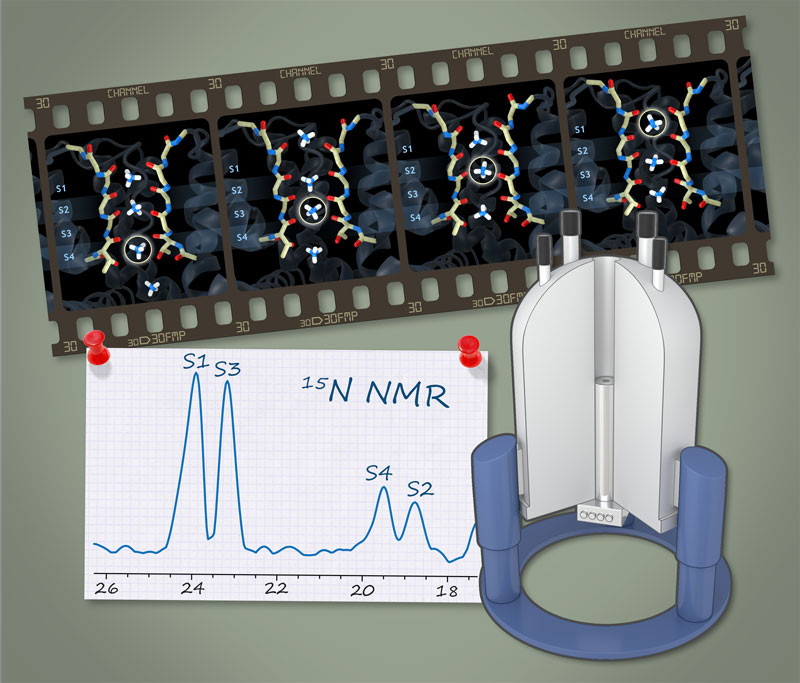Ion channels are important for all living organisms due to their involvement in several essential processes such as synaptic transmission, muscle contraction and cell signalling. They are situated in the cell membrane where they allow efficient and selective conduction of ions in and out of cells. HFSP Long-Term Fellow Carl Öster, in the group of Adam Lange at the Leibnitz-Institute for Molecular Pharmacology in Berlin, is using solid-state NMR to investigate ion channels that conduct sodium and/or potassium ions. Solid-state NMR is a structural biology technique that enables the study of membrane proteins under near-native conditions. The proteins are embedded into a lipid bilayer and the experiments can be conducted under physiological buffer conditions and at room temperature.

Figure: Dynamic ions in the selectivity filter of an ion channel (film strip) examined using solid-state NMR (spectrometer bottom right) and molecular dynamics simulations. (Illustration by Barth van Rossum, FMP Berlin).
In this work, that was conducted with collaborators at the Max Planck Institute for Multidisciplinary Sciences in Göttingen, the authors used ammonium ions to mimic potassium ions. Potassium ions can in principle be used in NMR experiments, but they give weak and broad signals and are therefore not suitable for studies of ion binding in proteins where the ions only make up a tiny fraction of the sample. Using 15N labelled ammonium ions, on the other hand, allows for detection of the commonly used nuclei 1H and 15N. The solid-state NMR experiments showed ammonium ions bound in the specific ion binding sites in the ion channels (see figure). Importantly, it was possible to distinguish between ions bound in different ion binding sites. Additionally, the authors showed that only an ion bound in an outer ion binding site is in close proximity to water. This is interesting since there are conflicting models for how ions are conducted through the selectivity filter of potassium selective ion channels. In the previously accepted mechanism, water molecules and potassium ions are conducted in an alternating fashion [1], whereas in a more recently proposed mechanism, potassium ions are conducted by direct interactions between the ions without water molecules in-between [2]. These new results strongly support that no water molecules are present between the ions and further confirm the results from a previous solid-state NMR study by Carl Öster and co-workers, where the ion conduction mechanism was investigated from the point of view of water molecules [3].
Carl Öster and co-workers are now planning to use the new method with ammonium ions to investigate how ligand binding affects ion binding in potassium-selective ion channels. This may be useful for future pharmacological studies of dysfunctional ion channels.
|
HFSP award information Long-Term Fellowship (LT000303/2019-L): Dissection of transmembrane ion-channel dynamics by proton detected solid state NMR Fellow: Carl Öster |


































